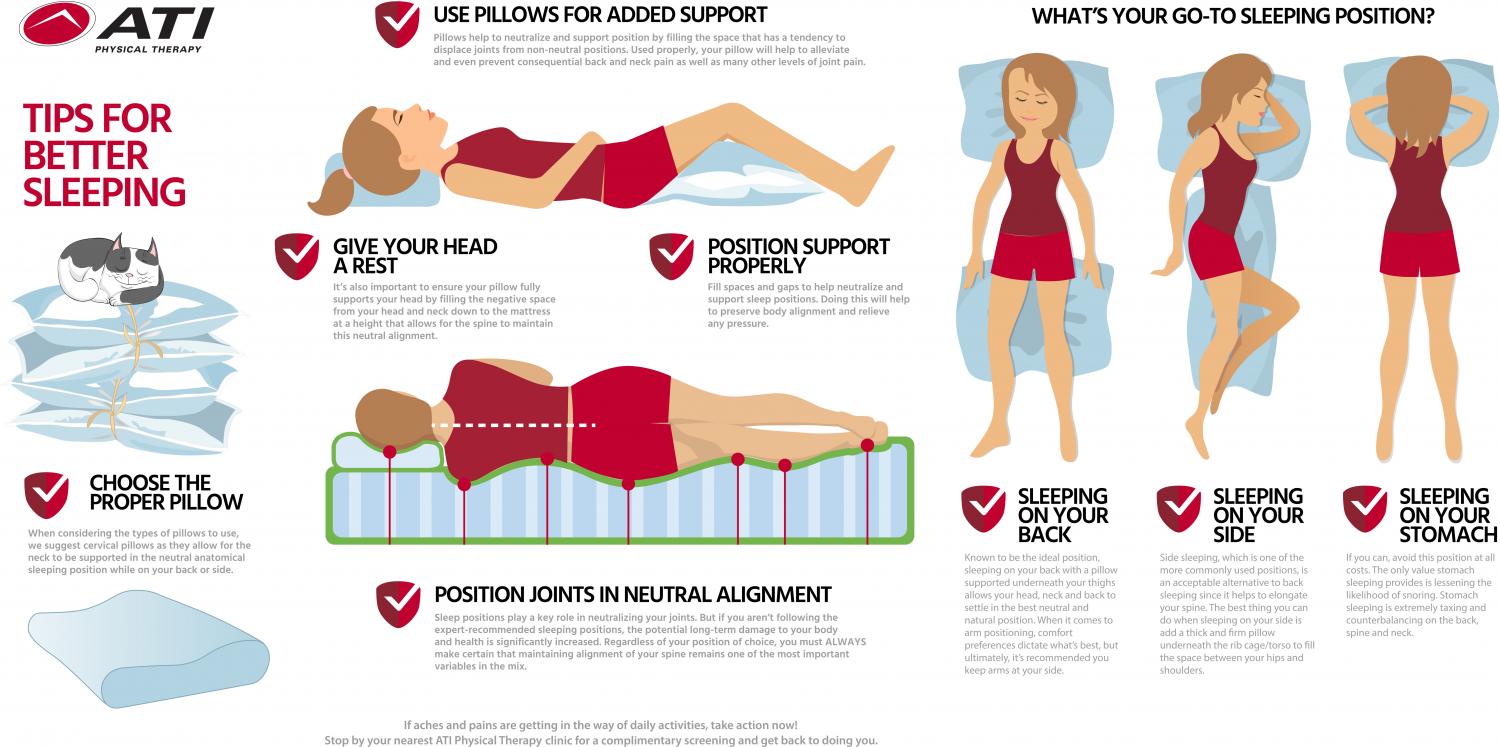Correct Sleeping Positions: What is the Proper Way to Sleep?

By: Brian Rog and Todd Sayer, PT, MBA
A good night’s rest should leave you energized and refreshed. But if you are like many Americans, restlessness and post-sleep pain is a regular occurrence and can negatively impact your everyday life. So, what is the proper way to sleep? The good news is that finding proper body alignment in bed and implementing a few simple changes to your daily and nightly routine can make a substantial and positive impact on how well you sleep each night.
Tips for Proper Body Alignment in Bed

Click here to view larger image
Sufficient sleep gives the body an opportunity to heal itself from a hard day’s work, leaving you feeling energized and mentally sharp. We recommend reviewing and incorporating these tips for proper sleep posture into your regular sleep routine:
Use pillows to support your frame
Sleep on your back
Aim for spinal alignment
Typical sleep routines will suggest sleep-inducing tactics such as setting a regular bedtime, using darkening shades, and listening to white noise. But when you combine their advice with ours, you are taking real steps towards alleviating pain and getting a good night’s rest.
Get Your Free Physical Therapy Screening
Not sure where to start with physical therapy? Get a free screening and let us help you start the path to recovery today.
Get My Complimentary Screening ›
The Proper Way to Sleep
The Proper Way to Sleep on a Pillow
Your pillow is important: pillows help to neutralize and support your sleeping position. They fill the space that tends to displace joints from non-neutral positions. When used properly, your pillow will help to alleviate and even prevent consequential joint, back and neck pain.
When considering the types of pillows to use, we suggest cervical pillows. These types of pillows allow for the neck to be supported in the neutral anatomical sleeping position while on your back or side.
It’s also important to ensure your pillow fully supports your head. You know your pillow is doing its job if it fills the negative space from your head and neck down to the mattress. When your pillow is at this height, it will allow for the spine to maintain neutral alignment.
Proper Sleep Posture for Neutral Alignment
Sleep positions play a key role in neutralizing your joints. But if you aren’t following the expert-recommended proper sleep posture, the potential long-term damage to your body and health is greatly increased. Regardless of your position of choice, you must ALWAYS try to make spine alignment a top priority.
How-To: Properly Sleep on Your Back
If you already sleep on your back, you are in luck! Sleeping on your back with a pillow supported underneath your thighs is known to yield a good night’s sleep. This type of sleeping posture allows your head, neck and back to settle in the best neutral and natural position. If you are wondering about what to do with your arms, comfort preferences dictate what’s best. However, if you want the expert’s opinion - it’s recommended you keep arms at your side.
How-To: Sleep on Your Side Properly
Though not ideal, side sleeping, which is one of the more commonly used positions, is an acceptable alternative to back sleeping. Side sleeping still helps to elongate your spine, and you can minimize potential negative impact by using a pillow.
Simply add a thick and firm pillow underneath the rib cage/torso to fill the space between your hips and shoulders. This will help to alleviate compression from the downside shoulder. Doing this may also help to eliminate a contributing variable to the development of shoulder dysfunctions.
Why to Avoid Sleeping on Your Stomach
Unfortunately, there is no real good way to sleep on your stomach. The only value stomach sleeping provides is lessening the likelihood of snoring. Stomach sleeping is extremely taxing and counterbalancing on the back, spine and neck.
Since most of our weight is in the middle of the body, stomach sleeping makes it difficult for your spine to sustain a neutral position. As for the neck, most stomach sleepers turn their head to the side to breathe. As a result, the head and spine are forced out of alignment and can lead to serious damage down the road.
If you are among the 17 percent unable to break away from stomach sleeping, consider using a flat pillow to reduce the angling of your neck. We also recommend sleeping with a pillow under the abdomen to take some of the pressure off your back and spine.
Ensure Your Structure is Supported Throughout
As we mentioned, maintaining proper alignment of your spine is by far one of the most important things you can do for your body. But how can you tell if your approach is effective? It’s simple: fill spaces and gaps to help neutralize and support correct sleep positions. Doing this will help to preserve body alignment and relieve any pressure.
The Good and the Bad
Like most things in life, desired outcomes rest on the amount of effort you put in. When it comes to sleep and your daily habits, if you are willing to make a few simple changes – whether it be avoiding your phone before bedtime or looking after your proper sleep posture, you’ll be doing your body much good in the long run.
If you feel like you’ve tried everything to improve your sleep but post-sleep aches and pains still follow you through the day, it’s time to act. Get in touch with one of our experts to set up a complimentary screening at your nearest ATI clinic or call (855) MY-ATIPT.
